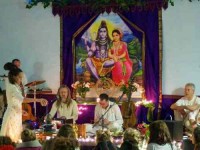Your shopping cart is empty!
Bhakti Yoga
Шивананда Йога Веданта Программа YTT London Centre 29-дневный-Шивананда-йога-подготовки учителей-в-Лондоне Великобритании
Система гурукуле образования
Курс основан на Indias традиционной системы преподаван..
3-х дней-заместитель сердца из-йога-ретриты-ик Yogaprema Retreat Йога Выходные Великобритания Программа
Плавные традиционные занятия хатха-йога, естественно, открыть сердце и лелеять вас в пространство капитуляции и н..
30 дней-500-часовой-йога-подготовки учителей-в-Индии Сриме школы Трансформационная Йога Индия Программа YTT
Этот уровень мастера 500 часов Трансформационное йога подготовки учителей курс четыре недели интенсивный курс..
7 дней-изобилие-все включено-йога-отступление в Италии-Обилие Йога Retreat - Италия Йога Расписание праздников
7:30 Свежеприготовленный пюре и соки
8:00 Утренняя йога: Wake-вверх ваши чувства - ф..
Krishna theologian Rupa Goswami has identified five major varieties of bhakti called bhava:
santa-bhava - neutral relationship with God
dasya-bhava - relationship with God, the relationship of servant to master
sakhya bhava - relationship with God as a friend
vatsalya-bhava - acting as the father or mother of God
madhurya-bhava - relationship to God as his beloved </ p>
Bhakti Yoga (Sanskrit भक्ति योग, bhakti yoga IAST.) - One of the four main types of yoga in Hindu philosophy. The practice of bhakti-yoga is aimed at cultivating the love of God through bhakti - service to God with love and devotion. The practice of bhakti-yoga is recommended in a number of sacred texts of Hinduism as the most easy and effective form of yoga. So, in the "Bhagavad-gita" proclaims its superiority over the other three main types of yoga - karma-yoga, jnana-yoga and raja yoga. Destinations in Hinduism, in which bhakti is the main practice are called bhakti movements. In Vaishnavism allocated nine basic forms of bhakti-yoga.
Movement bhakti are monotheistic and pantheistic in its orientation, and their followers worship Vishnu, Krishna, Shiva and Shakti as the supreme form of God. The Nirguna-bhakti is the object of worship in favor of the impersonal Absolute - Brahman. Different currents of bhakti, to a greater or lesser extent, were present at different stages of multi-millennial history of India & lt;. Br & gt;
Liberal inherently Bhakti movement often rejected strict caste tradition, speaking thus a haven for renegades orthodox Brahmanical Hinduism system. At the same time, it should be noted that the message of bhakti of love and tolerance is not always resonated with orthodox Hindus, committed to the strict rules of the caste system & lt;. Br & gt;
Bhakti was the reason for the birth of mass religious literature, different kinds of music and dance, as well as other forms of art that enrich the world, gave India a new impetus to the development, as well as help in overcoming the ritual and social restrictions in the Indian society & lt;. / p & gt;
As we have mentioned in the first article in this section (the true meaning of yoga), the word "bhakti" can be translated as "love and devotion", "yoga" - "union with God". Thus bhakti-yoga - a union with God in love and devotion. Bhakti-yoga - is the highest yoga system, all other systems are designed to lead the practitioner to bhakti-yoga. The knowledge achieved in jnana-yoga, control of vital air and meditation in ashtanga yoga system are only prerequisites for the development of the relationship of love with the Supreme Soul.
In the process of bhakti-yoga devotee cultivates one of the five kinds of bhakti, which is closest to his frame of mind. In Gaudiya Vaishnavism relationship with God as a lover regarded as the most sublime form of bhakti, which includes all the others. The supreme manifestation of this love Rupa Goswami describes the love of the gopis for Krishna Vrindavan.
The 'Bhakti rasamrta Sindhu "Rupa Goswami is a description of the nine processes of bhakti-yoga, following one or more of them can attain the highest perfection - pure love of God:
Shravan ( "Hearing God") - hearing stories from the scriptures that tell of God and repetition of the Holy Names of God (japa)
. Kirtan ( "glorify God".) - Chanting of the holy names of God or the description of His all-attractive features and acts
Smarana ( "remembrance of God") - internal meditation on the forms, names, actions or personality of God
. Pada-seva ( "service of the lotus feet of God".) - The execution of a particular individual to serve God
Archana ( "the worship of the Deity of God") - the worship (puja) of any of the forms of the Deity of God in Hinduism
. Vandana ( "offering prayers to God".) - Ascension various kinds of prayers to God
Dasya ( "service of God") - the execution of a service to meet God
. Sakhya ( "establishing friendly relations with God") - the establishment of friendly relations with God in the domestic level
. Atma nivedana ( "bringing only a sacrifice to God") - the tradition of all the thoughts and actions of God.
The first stage of spiritual realization - "I am spirit soul, rather than the temporary material body." If you understand this, you do not make sense to send their love outside, temporary, limited financial dimension. What do you do with your natural tendency to work and love? You need to redirect it to the Supreme Spirit who has a spiritual form, and that is personality - but not a material person. This internal exchange of love between the soul and the Supreme Soul, atma and Paramatma is called bhakti, and this is the true meaning of religion and yoga. </ P>
The self-realized soul is not opposed to continue to be in a material body in this world. She just wants to use his body in the service of Him with whom she has a domestic eternal loving relationship. The happiness that she feels having such a relationship of love, far superior to the happiness that can be experienced in this world, whether the happiness of sensual pleasure, or so-called love relationships.
Categories
- Anusara Yoga
- Aqua yoga
- Ashtanga Yoga
- Ayurveda Yoga
- Bhakti Yoga
- Bihar Yoga
- Bikram / Hot Yoga
- Dynamic Yoga
- Hatha Yoga
- Himalayan yoga
- Hridaya yoga
- Integral yoga
- Iyengar Yoga
- Jivamukti Yoga
- Kripalu Yoga
- Kriya Yoga
- Kundalini Yoga
- NEW INDIA
- Nidra Yoga
- Power Yoga
- Restorative Yoga
- Sivananda Yoga
- Tantra Yoga
- Taoist yoga
- Vinyasa Yoga
- Yin Yoga
- Yoga flow
- All yoga retreats
- DESTINATION: India +
- Costa Rica
- Greece
- Indonesia
- Italy
- Mexico
- Morocco
- Portugal
- Spain
- Thailand
- Turkey
- USA
Welcome visitor you can login or create an account.










